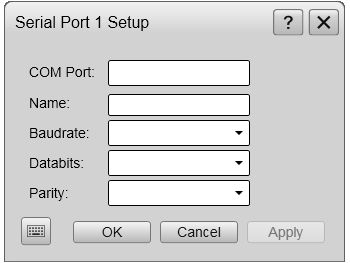Serial Port Setup dialog box
Serial line communication with external devices is important for the ST90 system. The communication between the ST90 system and peripheral devices takes place using "datagrams". For most commercial devices, the formats of the datagrams are defined by NMEA (National Marine Electronics Association). Use the Serial Port Setup dialog box to define the communication parameters for serial line ports. These ports are typically used to interface external devices, such as navigation sensors.
How to open
To open the Serial Port Setup dialog box, select a serial port on the I/O Setup page, and select Setup.
The I/O Setup page is located in the Installation and Output dialog boxes. The Installation dialog box is located on the Setup menu. The Output dialog box is located on the Operation menu.

Description
A serial port is a serial communication interface that is still very common between maritime systems. It is very important that any serial line between the ST90 system and any external system is setup correctly with identical parameters at each end. The NMEA (National Marine Electronics Association) standard for serial communication defines standard parameters for such interfaces.
According to their web site, the National Marine Electronics Association (NMEA) is "the unifying force behind the entire marine electronics industry, bringing together all aspects of the industry for the betterment of all in our business". For more information, see: http://www.nmea.org
Details
- COM Port
This text box identifies the current communication port on the Processor Unit. You can not change this information.
- Name
This is a text box. Type a suitable name for the communication port. If you do not have a computer keyboard connected to your ST90 system, select the Keyboard button to open an on-screen keyboard.
- Baud Rate
Use this setting to specify the baud rate ("speed") for the serial communication. The standard baud rate defined for NMEA serial line communication is 4800 baud.
- Data Bits
Use this function to specify the number of data bits for serial communication. The standard number of data bits defined for NMEA serial line communication is 8 (eight).
- Parity
Use this function to specify the parity for the serial communication. The standard parity defined for NMEA serial line communication is "None".
